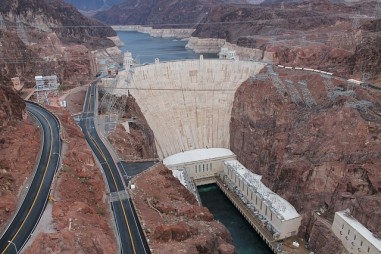What is Concrete?
Concrete is a mixture of aggregate (typically sand, gravel or crushed stone) held together by a binder, usually Portland cement. Creating Portland cement requires limestone, clay and gypsum. Today many builders use concrete for a great variety of applications. Here is a brief article on concrete history.
Who Invented Concrete?


While its exact origins are unknown, a Greek royal palace dating to around 1300 B.C. had a concrete floor. The Nabateans, best known for constructing the city of Petra, used it to build the cisterns which allowed them to survive in the desert. The Romans mad extensive use of concrete, beginning around 300 B.C. It was the primary building material for the Coliseum in Rome.
Development of Modern Concrete
Concrete quality deteriorated after the collapse of the Roman empire, but eventually improved to its former standards. The beginning of the Industrial Age saw numerous improvements in concrete. In 1793 a brilliant British engineer named John Smeaton developed a better method for producing hydraulic lime. He heated limestone and clay to produce a material called clinker. He then ground the clinker into powder.
Smeaton’s work eventually led to the development of Portland cement. Joseph Apsdin patented the material in 1824. He also gave it the name Portland cement, because its appearance was similar to Portland stone. His son William later developed an improved version by increasing the amount of limestone and heating it to a higher temperature.
Concrete has a high compressive strength, but it is weak in compression. This led to the development reinforced concrete, where steel bars and placed inside the concrete to improve the tensile strength. A Frenchman named François Coignet first used reinforced concrete for building in 1853. He built a four-story house in 1853. The following year William Wilkson used it on a two-story cottage in England. The first house with reinforced concrete was built in the United States in 1875. The builder used concrete instead of wood because of his wife’s fear of fire.
As bicycles and then cars became popular modes of transportation, there was a need for improved roads in the United States. In 1891 George Bartholomew poured the first concrete street in the country. Court Street in Bellefontaine, Ohio is still in use today. Ohio also had another concrete first. At 16-stories tall, the Ingalls Building in Cincinnati was the first high-rise concrete building.


Dams contain huge amounts of concrete. Here are a few examples:
- Hoover Dam (1935) 3,250,000 cubic yards
- Gran Coulee Dam (1942) 12,000,000 cubic yards
- Three Gorges Dam (2008) 37,000,000 cubic yards
The Future of Concrete
Builders use concrete because it is an incredibly useful material that is strong, inexpensive and made from common materials. Unfortunately, it also releases a lot of greenhouse gas. Globally, it is responsible for around eight percent of carbon dioxide emissions. Most of this occurs when limestone and clay are heated to high temperatures to produce Portland cement. Burning fuel to heat the mixture also produces some carbon dioxide. There is also a chemical reactions which occurs that emits carbon dioxide. Producing a pound of Portland cement releases approximately one pound of carbon dioxide.
Researchers are attempting to reduce the emissions from concrete production by reducing the amount of Portland cement used. Fly ash, a waste product from coal power plants, can be used in place of some of the Portland cement. Slag, a by-product of refining ores to create metals, can also re used as a substitute after it is ground up.
